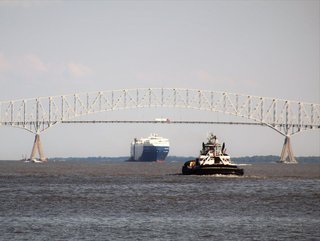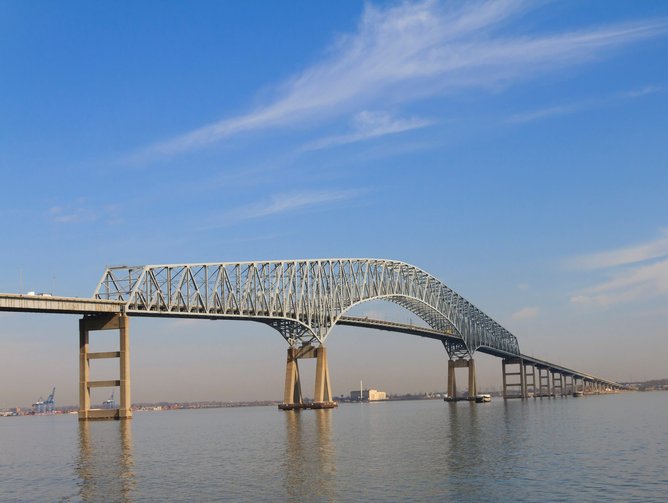Supply Chain Lessons to Learn from Baltimore Bridge Collapse

We’re now more than a week on from the collapse of Francis Scott Key Bridge in Baltimore, which came down after being struck by the Dali cargo ship.
The tragic incident is presumed to have claimed the lives of six construction workers.
Built by Hyundai Heavy Industries, one of the largest shipbuilders in the world, the Dali had been chartered by Maersk for a trip from Baltimore to Sri Lanka. However, its pilot issued a mayday distress call in the early hours of Tuesday, 26 March, saying the vessel had lost power and the steering system had malfunctioned.
Travelling too quickly to change course, the Dali collided with a bridge column and sent the structure plunging into the Patapsco River.

At the time of writing, the 948ft (289m) container ship remains partially wedged beneath the bridge, with all 21 crew members – 20 of which are Indian citizens – still on board and unable to disembark.
The tragedy has, inevitably, resulted in significant supply chain disruption, although a temporary shipping route has now opened near the collapsed bridge.
This means some commercial vessels can resume operations in and out of the Port of Baltimore – one of the busiest facilities of its kind in the US.
Supply chain vulnerability exposed
The collapse of Francis Scott Key Bridge, and shipping headaches caused as a result, is the latest in a string of incidents to hit the supply chain space.
While it won’t have the same level of impact as major disruptions like the blockage of the Suez Canal in 2021, or the recent militant attacks on merchant vessels in the Red Sea, it has once again demonstrated the vulnerability of global supply chains.
“The disruption comes as geopolitical conflicts and natural disasters wreak havoc elsewhere,” says Harry Murphy Cruise, an Economist at Moody’s Analytics.
“Shipping headed for the Suez Canal is being disrupted from attacks by Houthi rebels, while drought is limiting shipping through the Panama Canal. What’s more, industrial actions in some key ports, including in Australia and Finland, are adding to delays.
“All that is to say, it won’t take much to hobble supply chains and reinflate price pressures.”
Assessing third-party risk management strategies
As vulnerabilities within critical infrastructure are exposed, Guy Ornes, a Third-Party Risk Management Advisor at Fusion Risk Management, emphasises the pressing need for businesses to reassess their third-party risk management strategies.
This is especially valid when it comes to the Port of Baltimore, which plays a crucial role in handling a significant volume of the US’ automotive and agricultural equipment imports.
“In light of recent events, it's imperative for organisations to engage their third parties in a rigorous dialogue about their business continuity plans, including business impact analysis and exercise walkthroughs,” Guy explains.

“These discussions should form an integral part of the third-party risk management due diligence process, ensuring adequate controls are in place to mitigate the repercussions of such incidents.
“For third parties deemed essential, organisations must consider establishing redundancies or alternative plans. This could mean identifying back-up third parties or, pertinent to the current situation, alternative transportation routes or ports. Grasping the criticality of third parties and their involvement in business processes is fundamental to both anticipating the potential impact of crises like these and minimising business disruptions.”
Lessons already learned?
In the aftermath of the bridge collapse, US Secretary of Transportation Pete Buttigieg warned: “This will be a major and protracted impact to supply chains.”
Kevin O’Marah, Co-Founder of Zero100, has a different take. Baltimore might be a key port for roll-on/roll-off shipments, including cars, trucks and farm equipment, but Kevin points to the fact these are finished goods.

It means the ripple effects seen in Europe, when parts held up by Red Sea attacks forced stoppages at Tesla and Volvo assembly plants, won’t be an issue this time around.
Kevin believes vigilance and resilience strategies, implemented in light of the pandemic, are actually already working.
“Technology-heavy logistics firms like project44 and Flexport, which track and help manage global shipping for big companies, are already rerouting shipments that were headed to Baltimore,” he adds.
“Transportation and logistics leaders have significantly improved resilience since the COVID-19 crisis, meaning most are already well into contingency plans in response to this disruption.”
******
Check out the latest edition of Supply Chain Magazine and sign up to our global conference series – Procurement and SupplyChain LIVE 2024.
******
Supply Chain Digital is a BizClik brand.






